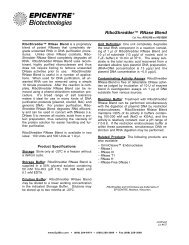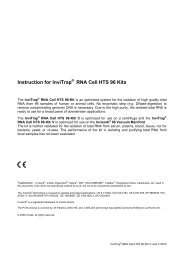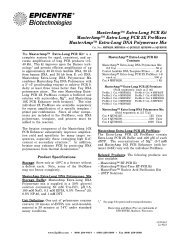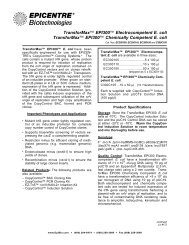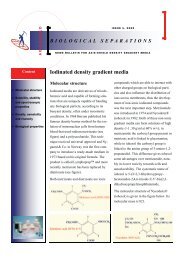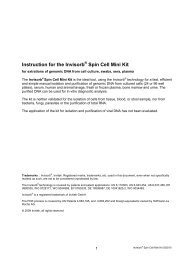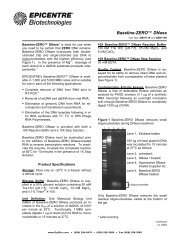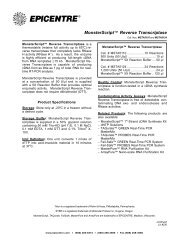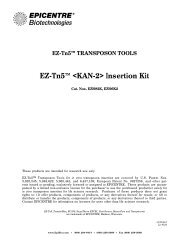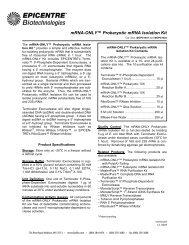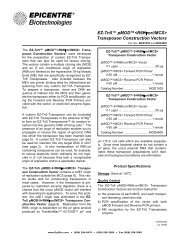OptiPrep™ The ideal density gradient medium for the purification of ...
OptiPrep™ The ideal density gradient medium for the purification of ...
OptiPrep™ The ideal density gradient medium for the purification of ...
- No tags were found...
You also want an ePaper? Increase the reach of your titles
YUMPU automatically turns print PDFs into web optimized ePapers that Google loves.
AXIS-SHIELDISSUE 10, 2009BIOLOGICAL SEPARATIONSNEWS BULLETIN FOR AXIS-SHIELD DENSITY GRADIENT MEDIAApplications• Isolation <strong>of</strong> PM fromcardiac muscle byflotation• Isolation <strong>of</strong> PM anddomains using cationiccolloidal silica• Isolation <strong>of</strong> PM byflotation through acontinuous <strong>gradient</strong>(16h spin)• Isolation <strong>of</strong> PM usinga discontinuous <strong>gradient</strong>• Isolation <strong>of</strong> PM bysedimentationthrough a pre-<strong>for</strong>med<strong>gradient</strong> (1-3h spin)• Detergent-free <strong>purification</strong><strong>of</strong> caveolae• Purification <strong>of</strong> detergent-resistantlipidrafts• Purification <strong>of</strong> lipidrafts in <strong>the</strong> absence<strong>of</strong> detergentOptiPrep<strong>The</strong> <strong>ideal</strong> <strong>density</strong> <strong>gradient</strong> <strong>medium</strong> <strong>for</strong> <strong>the</strong><strong>purification</strong> <strong>of</strong> plasma membrane and domainsOptiPrep is a sterile endotoxintested solution <strong>of</strong> 60% iodixanol in waterwith a <strong>density</strong> <strong>of</strong> 1.32 g/ml.Iodixanol was developed as an X-raycontrast <strong>medium</strong> an has <strong>the</strong>re<strong>for</strong>e beensubjected to rigorous clinical testing.Iodixanol is non-ionic, non-toxic tocells and metabolically inert.Iodixanol solutions can be made isoosmoticat all useful densities.Iodixanol solutions have low viscosityand osmolarity.OptiPrep is manufactured in compliancewith current EU guide to cGMP.Actual endotoxin levels in each batchare usually measured at < 0.13 EU/ml.OptiPrep <strong>of</strong>fers three <strong>gradient</strong> <strong>for</strong>mats<strong>for</strong> <strong>the</strong> isolation <strong>of</strong> <strong>the</strong> plasmamembrane (PM).Continuous or discontinuous <strong>gradient</strong>s(1-3h)Continuous <strong>gradient</strong>s (12-16h)Flotation through discontinuous <strong>gradient</strong>sOptiPrep <strong>of</strong>fers two approaches to<strong>the</strong> <strong>purification</strong> <strong>of</strong> lipid-rich micro domains.<strong>The</strong> first to be developed involves <strong>the</strong>isolation <strong>of</strong> caveolae from a sonicatedtotal plasma membrane fraction. Thisstrategy has also been used <strong>for</strong> <strong>the</strong> isolation<strong>of</strong> lipid rafts.<strong>The</strong> lipid-rich nature <strong>of</strong> <strong>the</strong>se microdomainsrenders <strong>the</strong>m relatively insensitiveto detergent solubilisation, comparedto <strong>the</strong> rest <strong>of</strong> <strong>the</strong> plasma membraneand this <strong>for</strong>ms <strong>the</strong> basis <strong>of</strong> <strong>the</strong>irseparation in detergent containing iodixanol<strong>gradient</strong>s.
BIOLOGICAL SEPARATIONSPage 2Isolation <strong>of</strong> plasma membrane <strong>for</strong>m cardiac muscle by flotationUsing iodixanol <strong>gradient</strong>s, isolation <strong>of</strong> a plasma membrane(PM) fraction is <strong>of</strong>ten achieved simultaneouslywith <strong>the</strong> <strong>purification</strong> <strong>of</strong> o<strong>the</strong>r subcellular membranes.Most <strong>of</strong> <strong>the</strong>se methods are suitable <strong>for</strong> work with culturedcells and s<strong>of</strong>t tissues such as liver but tissues suchas muscle <strong>of</strong>ten require a customized method. Never<strong>the</strong>lesssome <strong>of</strong> <strong>the</strong> o<strong>the</strong>r iodixanol <strong>gradient</strong>s may be adaptableto muscle tissue.Research into cardiac muscle function <strong>of</strong>ten involves <strong>the</strong>complex intracellular processes by which <strong>the</strong> GLUT4glucose transport protein is translocated to and from <strong>the</strong>plasma membrane (sarcolemma). Thus in fractionations<strong>of</strong> cardiac muscle, a prime requirement is to be able resolve<strong>the</strong> plasma membrane from GLUT-4 transportvesicles and o<strong>the</strong>r membrane compartments. <strong>The</strong> overallstrategy <strong>of</strong> this flotation <strong>gradient</strong> protocol is thus similarto that using a cultured cell line but <strong>the</strong> details <strong>of</strong> <strong>the</strong>technique are ra<strong>the</strong>r different.<strong>The</strong> PM is usually <strong>the</strong> least dense <strong>of</strong> all <strong>the</strong> subcellularmembranes and our application highlights a novel exploitation<strong>of</strong> this property. In this protocol, a crudeplasma membrane suspension is adjusted to a <strong>density</strong>(1.049 g/ml, equivalent to 5% w/v iodixanol) justgreater than that <strong>of</strong> <strong>the</strong> plasma membrane <strong>of</strong> cardiacmuscle, thus during <strong>the</strong> centrifugation <strong>the</strong> plasma membranewill float to <strong>the</strong> top <strong>the</strong> liquid. By layering <strong>the</strong>sample upon a small cushion <strong>of</strong> 15% (w/v) iodixanol(1.103 g/ml) and centrifuging <strong>for</strong> 16 h, a shallow <strong>gradient</strong>will <strong>for</strong>m due to diffusion <strong>of</strong> iodixanol and also tosome sedimentation <strong>of</strong> iodixanol molecules close to <strong>the</strong>bottom <strong>of</strong> <strong>the</strong> tube. This will <strong>the</strong>re<strong>for</strong>e allow not onlyisolation <strong>of</strong> <strong>the</strong> plasma membrane, but also partial fractionation<strong>of</strong> some <strong>of</strong> <strong>the</strong> denser membrane compartments.Flotation <strong>of</strong>ten provides better recovery and/or resolution<strong>of</strong> <strong>the</strong> least dense components <strong>of</strong> a crude fractionthan does sedimentation. Overloading <strong>the</strong> <strong>gradient</strong>(instability <strong>of</strong> <strong>the</strong> sample/<strong>gradient</strong> interface) cannot occurin a flotation <strong>for</strong>mat. <strong>The</strong> particular <strong>for</strong>mat describedin this protocol also allows <strong>the</strong> sample to becontained within a relatively large volume; this alsominimizes interactions between particles in <strong>the</strong> <strong>gradient</strong>.For detailed protocols and references see S27 on <strong>the</strong>OptiPrep Application CD or online at: www.axisshield-<strong>density</strong>-<strong>gradient</strong>-media.comIsolation <strong>of</strong> plasma membrane using a continuous <strong>gradient</strong>Although both continuous and discontinuous iodixanol<strong>gradient</strong>s, centrifuged <strong>for</strong> 1-3 h have been used <strong>for</strong> <strong>the</strong>isolation <strong>of</strong> a plasma membrane (PM) fraction, <strong>of</strong>tensimultaneously with <strong>the</strong> <strong>purification</strong> <strong>of</strong> o<strong>the</strong>r subcellularmembranes, <strong>the</strong>re is evidence that resolution is <strong>of</strong>tenimproved by centrifugation <strong>for</strong> longer periods, since it isonly under <strong>the</strong>se conditions that true equilibrium <strong>density</strong>banding is achieved. In this method two strategies, employing<strong>the</strong> longer centrifugation time <strong>for</strong>mat are presented.Dunphy et al and Woods et al applied <strong>the</strong> postnuclearfraction to a continuous iodixanol <strong>gradient</strong>,while Bivona et al initially used a discontinuous sucrose<strong>gradient</strong> to provide a crude plasma membrane be<strong>for</strong>eloading on to <strong>the</strong> continuous iodixanol <strong>gradient</strong>.Generally <strong>the</strong> most successful <strong>gradient</strong>s <strong>for</strong> <strong>purification</strong><strong>of</strong> <strong>the</strong> PM cover a lower <strong>density</strong> range than do thoseprimarily aimed at resolving <strong>the</strong> Golgi and endoplasmicreticulum (ER) but because <strong>the</strong> <strong>density</strong> <strong>of</strong> <strong>the</strong> plasmamembrane (and o<strong>the</strong>r compartments) varies with <strong>the</strong>cell or tissue source, customized <strong>gradient</strong>s may coverei<strong>the</strong>r a broader and/or higher <strong>density</strong> range. <strong>The</strong>re ishowever ano<strong>the</strong>r consideration in selection <strong>of</strong> <strong>the</strong><strong>density</strong> range <strong>of</strong> <strong>the</strong> iodixanol <strong>gradient</strong>. Because Bivonaet al used a fraction containing principally PM and ER,<strong>the</strong>y were able to use a shallow low-<strong>density</strong> <strong>gradient</strong>
ISSUE 10, 2009Page 3(5-20% (w/v) iodixanol. A total post-nuclear fractionhowever also contains organelles such as mitochondriaand peroxisomes which are much more rapidly sedimentingthan <strong>the</strong> small vesicles <strong>of</strong> <strong>the</strong> PM and ER andmay disturb such shallow low-<strong>density</strong> <strong>gradient</strong>s. ThusDunphy et al and Woods et al chose steeper <strong>gradient</strong>scovering a wider <strong>density</strong> range.For a detailed protocol and references see S25 on <strong>the</strong>OptiPrep Application CD or online at www.axisshield-<strong>density</strong>-<strong>gradient</strong>-media.comDetergent free <strong>purification</strong> <strong>of</strong> caveolae by sonication <strong>of</strong> a PM fractionThis is a detergent-free strategy and was first describedby Smart et al <strong>for</strong> <strong>the</strong> isolation <strong>of</strong> a caveolae from humanfibroblasts. It was later modified by Babitt et aland subsequently it has been applied ei<strong>the</strong>r in <strong>the</strong> originalor <strong>the</strong> revised <strong>for</strong>m (without any fur<strong>the</strong>r adaptation)to a wide range <strong>of</strong> o<strong>the</strong>r cell types and to membranefractions from brain tissue, <strong>the</strong> parathyroid gland andchicken intestinal mucosal epi<strong>the</strong>lium.10-20%23%5%15%~25%According to all published papers <strong>the</strong> sonicated plasmamembrane suspension is adjusted to 23% iodixanol andlayered beneath a continuous 10-20% iodixanol <strong>gradient</strong>and centrifuged at 52,000g <strong>for</strong> 90 min. After harvesting<strong>the</strong> <strong>gradient</strong> (from <strong>the</strong> top) in 15 fractions morethan 95% <strong>of</strong> <strong>the</strong> protein was detected in fractions 9-15while <strong>the</strong> caveolin was more or less confined to fractions3-12. In <strong>the</strong> top 7 or 8 fractions <strong>the</strong>re<strong>for</strong>e <strong>the</strong> specificactivity <strong>of</strong> <strong>the</strong> caveolin is very high and it is thiscut <strong>of</strong> <strong>the</strong> <strong>gradient</strong> which is processed fur<strong>the</strong>r in <strong>the</strong>concentration phase.Approximately <strong>the</strong> top half <strong>of</strong> <strong>the</strong> <strong>gradient</strong> is readjustedto 23% iodixanol; in <strong>the</strong> original method this was <strong>the</strong>n52,000g/90 min52,000g/90 minoverlaid with a solution <strong>of</strong> 5% iodixanol and <strong>the</strong> centrifugationrepeated to allow <strong>the</strong> caveolae to bandsharply at <strong>the</strong> interface. Subsequently a layer <strong>of</strong> 15%iodixanol was interposed to remove any denser proteinrichmaterial harvested from <strong>the</strong> first <strong>gradient</strong> (see figure).Some <strong>of</strong> <strong>the</strong> published papers report <strong>the</strong> use <strong>of</strong> <strong>the</strong>original second <strong>gradient</strong>, some use <strong>the</strong> modification.For a detailed protocol and references see S35 on <strong>the</strong>OptiPrep Application CD or online at www.axisshield-<strong>density</strong>-<strong>gradient</strong>-media.comPurification <strong>of</strong> lipid rafts as detergent-resistant membranes /DRMs)In one <strong>of</strong> <strong>the</strong> most widely used strategies, lipid raft isolationis based on <strong>the</strong> insolubility <strong>of</strong> <strong>the</strong>se domains in anon-ionic detergent such as Triton X100. Detergent isadded ei<strong>the</strong>r to intact cells or a postnuclear supernatant,which is <strong>the</strong>n normally adjusted to a high <strong>density</strong> andlayered under a discontinuous <strong>gradient</strong>. Lipid rafts,which have a relatively low <strong>density</strong>, float away fromsoluble proteins and dense cytoskeleton- associatedproteins, which remain in <strong>the</strong> load zone. Originally sucrose<strong>gradient</strong>s were used <strong>for</strong> <strong>the</strong> separation but whenNycodenz® flotation <strong>gradient</strong>s were introducedNaslavsky et al observed that <strong>the</strong>se <strong>gradient</strong>s were farsuperior to those <strong>of</strong> sucrose.Routinely cell lysis or homogenisation is per<strong>for</strong>med in abuffered saline containing a chelating agent, a detergent,
Web:www.axis-shield-<strong>density</strong>-<strong>gradient</strong>media.comAXIS-SHIELDIn this leaflet we have presented some <strong>of</strong> <strong>the</strong> applicationsavailable <strong>for</strong> <strong>the</strong> isolation <strong>of</strong> plasma membrane anddomains using OptiPrep. More in<strong>for</strong>mation can befound at: www.axis-shield-<strong>density</strong>-<strong>gradient</strong>media.com.On <strong>the</strong> front page click on “Subcellularmembranes and cell organelles”.PO Box 6863 RodelokkaN-0504 OsloNorwayPhone: +47 24 05 60 00Fax: +47 24 05 60 10Email: bjh@no.axis-shield.com orjohn@jgrescon.fsbusiness.co.ukprotease inhibitors and/or o<strong>the</strong>r additives such as DTTor CaCl 2 . Whe<strong>the</strong>r <strong>the</strong> light mitochondrial fraction isused to prepare Golgi membranes depends on <strong>the</strong>ir responseto homogenization; if <strong>the</strong>y vesiculate <strong>the</strong>y willbe recovered in <strong>the</strong> microsomal fraction; if <strong>the</strong>y retain atubular structure <strong>the</strong>y will be recovered in <strong>the</strong> light mitochondrialfraction. <strong>The</strong>y are <strong>the</strong> least dense membranein <strong>the</strong> light mitochondrial fraction and can be effectivelyisolated in a self-generated OptiPrep <strong>gradient</strong>(see figure).Pre-<strong>for</strong>med <strong>gradient</strong> may also be used. Note that <strong>the</strong>isolation <strong>of</strong> Golgi membrane vesicles and o<strong>the</strong>r components<strong>of</strong> <strong>the</strong> secretory endocytic and syn<strong>the</strong>tic systemsare described elsewhere.Lyse cells in buffer+ detergent± liquid shearDRM150,000-180,000g4 hDisrupt cells in bufferby liquid shearAdd detergentBuffer20%30%35%Disrupt cells in bufferby liquid shear1000-3000g/5 minSupernatantAdd detergentMaintain at 4 o C <strong>for</strong> 30 minAdjust to 40% iodixanolFor a detailed protocol and references see S33 on <strong>the</strong>OptiPrep Application CD or online at: www.axisshield-<strong>density</strong>-<strong>gradient</strong>-media.com




